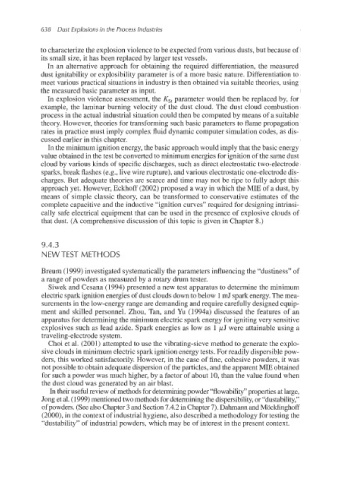Page 671 - Dust Explosions in the Process Industries
P. 671
638 Dust Explosions in the Process Industries
to characterize the explosion violence to be expected from various dusts, but because of
its small size, it has been replaced by larger test vessels.
In an alternative approach for obtaining the required differentiation, the measured
dust ignitability or explosibility parameter is of a more basic nature. Differentiation to
meet various practical situations in industry is then obtained via suitable theories, using
the measured basic parameter as input.
In explosion violence assessment, the K,, parameter would then be replaced by, for
example, the laminar burning velocity of the dust cloud. The dust cloud combustion
process in the actual industrial situation could then be computed by means of a suitable
theory. However, theories for transforming such basic parameters to flame propagation
rates in practice must imply complex fluid dynamic computer simulation codes, as dis-
cussed earlier in this chapter.
In the minimum ignition energy, the basic approachwould imply that the basic energy
value obtainedin the test be convertedto minimum energies for ignition of the same dust
cloud by various kinds of specific discharges, such as direct electrostatic two-electrode
sparks,break flashes (e.g., live wire rupture), and various electrostaticone-electrodedis-
charges. But adequate theories are scarce and time may not be ripe to fully adopt this
approach yet. However, Eckhoff (2002) proposed a way in which the MIE of a dust, by
means of simple classic theory, can be transformed to conservative estimates of the
complete capacitive and the inductive “ignition curves” required for designing intrinsi-
cally safe electrical equipment that can be used in the presence of explosive clouds of
that dust. (A comprehensive discussion of this topic is given in Chapter 8.)
9.4.3
NEW TEST METHODS
Breum (1999) investigated systematicallythe parameters influencing the “dustiness” of
a range of powders as measured by a rotary drum tester.
Siwek and Cesana (1994) presented a new test apparatus to determine the minimum
electric spark ignition energies of dust clouds down to below 1mJspark energy.The mea-
surementsin the low-energyrange are demanding and require carefully designed equip-
ment and skilled personnel. Zhou, Tan, and Yu (1994a) discussed the features of an
apparatus for determiningthe minimum electric spark energy for igniting very sensitive
explosives such as lead azide. Spark energies as low as 1 pJ were attainable using a
traveling-electrodesystem.
Choi et al. (2001) attempted to use the vibrating-sievemethod to generate the explo-
sive clouds in minimum electric spark ignition energy tests. For readily dispersiblepow-
ders, this worked satisfactorily.However, in the case of fine, cohesive powders, it was
not possible to obtain adequate dispersion of the particles, and the apparent ME obtained
for such a powder was much higher, by a factor of about 10, than the value found when
the dust cloud was generated by an air blast.
In their useful review of methodsfor determiningpowder “flowability”propertiesat large,
Jong et al. (1999)mentionedtwo methods for determiningthe dispersibility,or “dustability,”
of powders. (See also Chapter3 and Section7.4.2in Chapter7). Dahmann and Mocklinghoff
(2000), in the context of industrial hygiene, also described a methodology for testing the
“dustability” of industrial powders, which may be of interest in the present context.

